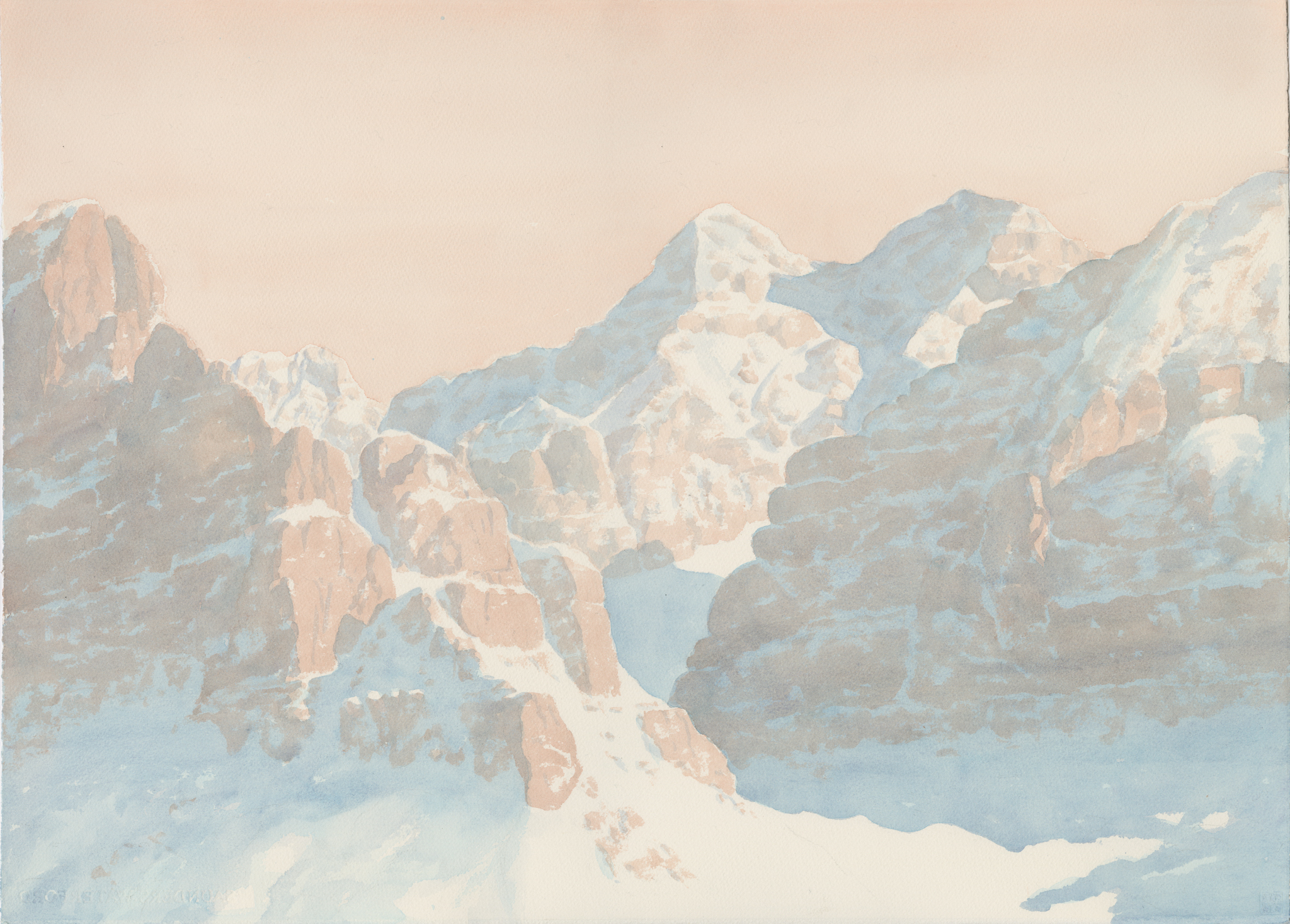Riccarda de Eccher, an Italian-born artist, has always had a deep connection with mountains, a subject that continues to dominate her artistic work. Growing up near the mountains in Northern Italy, de Eccher’s love for these majestic natural structures was shaped by her early experiences as a climber.

“The subject matter that I paint is mountains, and it’s very dear to me,” de Eccher says. Her connection to mountains, both personal and artistic, runs deep, with the towering peaks serving as a source of inspiration throughout her life.
Between the ages of 20 and 30, de Eccher was an avid climber, taking on challenging expeditions in some of the world’s highest ranges.
“I climbed on rocks, on the most difficult routes in those days,” she recalls. “I was also among the first women to participate in Himalayan expeditions.”
In 1977, de Eccher took part in an expedition to Annapurna III, one of the most formidable peaks in the Himalayas. Later, in 1980, she joined a Mount Everest expedition. Although she didn’t reach the summit due to weather conditions, her participation in these ventures was significant, especially in a time and place where it was uncommon for women to embark on such dangerous expeditions.
“It was not very common, especially in Italy. It’s not very advanced in terms of women in climbing,” de Eccher explains. “So, it was pretty unusual.”
Despite her early accomplishments as a climber, de Eccher’s transition into painting came much later in life. She started painting in her late 40s, a time when many artists might already be well-established.
“I was almost 50 when I started painting and it was something that I became so passionate about. For me, it was like a kind of love at first sight,” she says, reflecting on the moment she found her calling. Having never painted or drawn before, de Eccher was initially uncertain about her new path. Her passion for art quickly blossomed and she found herself drawn to the same subject matter that had defined her youth: mountains.
De Eccher primarily works with watercolors, a medium she has favored since she first began painting.
“I have always used watercolor as the medium because it’s what I started with at the beginning,” she says. “It’s a difficult technique, but the pigment is transparent, so the luminosity of the paper comes through. I think that works with what I paint—the mountains.”
The delicacy and transparency of watercolor allow de Eccher to capture the serene beauty and light that embody the mountains she loves.
Her artwork evokes a sense of calm and tranquility, a reflection of her journey and outlook on life.
“Sometimes I think, what kind of artist would I have been if I had started as a young woman?” de Eccher wonders. “But I started later in life when I had already smoothed my corners.”
At nearly 70 years old, de Eccher feels that her art reflects a mature perspective, one increasingly focused on beauty and harmony.
“The older I get, the more I’m in search of beauty and harmony,” she adds, emphasizing how her art mirrors her internal growth.

Painting has become more than just a creative outlet for de Eccher; it’s a necessity.
“It’s a need. If I don’t paint for a few days, I become kind of crazy,” she admits with a laugh. The act of painting allows her to channel the passion she once had for climbing into a new, safer medium. “When you’re 25, you go climbing and risk your life, and you think it’s okay,” she says. “But as you get older, you understand danger in a very different way. Now, I can still be in the mountains in another form—through my art.”
De Eccher’s life as a climber has profoundly shaped her artistic process. Just as she meticulously planned her climbs, she takes great care with her paintings. Working in watercolor requires precision, as mistakes cannot be easily corrected.
“When you put your brush on the paper, you cannot erase it. You cannot fix the problem,” she explains. “In oil painting, there are what they call ‘pentimenti,’ [a visible trace of earlier painting beneath a layer or layers of paint on a canvas] which is an Italian word for regrets. But there are no regrets in watercolor.”
Her painting process is deliberate and involves careful preparation. de Eccher often starts with a drawing, followed by small studies of the subject before moving on to larger pieces. “The larger I paint, the more I want to have worked out all the problems in studies before,” she says. A small painting might take two hours, but creating a larger piece can take up to a month of planning and execution.
One of the aspects of painting that de Eccher finds most fulfilling is how it allows her to stay connected to the mountains she loves.
“Because I paint something I have a real passion for, it helps me stay there, in that place,” she says. Her passion for mountains and art has created a balance in her life that she values deeply. “I found a way to place my passion in something that makes me happy.”
As someone who discovered her artistic talent later in life, de Eccher offers advice to aspiring artists: “Don’t let any day go by without drawing a line,” she says, quoting an ancient Roman painter. “Devotion, passion, and drawing are key. People are often charmed by colors, but the spine of the work is the drawing. I think we don’t draw enough.”
She emphasizes that practice is crucial, and even on days when inspiration feels distant, continuing to work is important. “Picasso said it best: you need to have inspiration, but inspiration needs to find you at work,” she adds.
De Eccher’s journey as an artist is a testament to the idea that it’s never too late to find your passion.
“I’m very happy with the climbs I did and the life I had. I feel very privileged,” she reflects. “Most of all, I’m privileged because I’m still alive. Now, through painting, I can still be in the mountains, in a way that suits my age.”
Having lived in Oyster Bay for more than 30 years, de Eccher has found inspiration not only in the mountains but also in the beauty of her surroundings.
“The light here is so beautiful,” she says, noting how it affects her work. “When Henri Matisse came to New York, he said it would become the center of art because of the light. It struck me when I came back from Italy—the light here is a joy.”
De Eccher’s art, deeply personal and rooted in her love of nature, continues to evolve as she grows older. As she approaches her 70th birthday, her work reflects not only the mountains she once climbed but also her search for harmony, beauty and peace in the world around her.
De Riccarda’s work is on display in the juried exhibition, “The Body Politic: Long Island Biennial,” at The Heckscher Museum of Art through Jan. 19 at The Heckscher Museum of Art (2 Prime Ave., in Huntington). Visit Heckscher.org for the full list of local artists and more details.
Visit www.deeccher.net to view more of de Eccher’s work.




